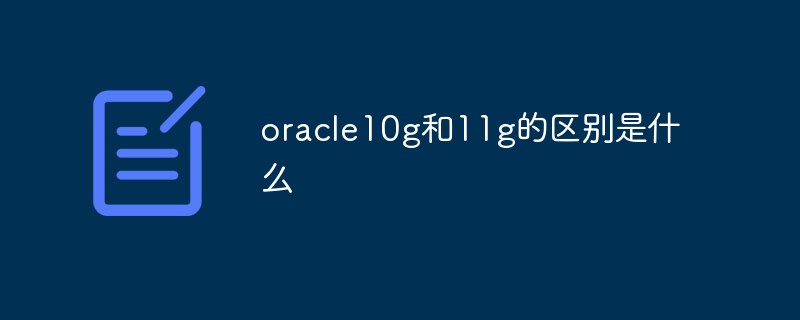Differences: 1. Oracle10g does not support the continue solution and does not support the column-to-row function, but it is supported in Oracle11g; 2. Oracle10g does not support ASM in clusters, but clusters in Oracle11g support ASM.

The operating environment of this tutorial: Windows 10 system, Oracle 11g version, Dell G3 computer.
There is a new party function in 11g, which is not supported by 10g, as follows:
listagg(b.person_name) within group(order by a.id) applyPerson,
2. Oracle10g does not support the continue solution, and The column-to-row function is not supported, but 11g supports:
select deptno, job, sum(sal) total_salq from emp group by deptno, job order by 1;
continue; It finally appeared in 11g and solved many application problems.
In Oracle 11g, data security requirements are getting higher and higher, and the Transparent Data Encryption (TDE) feature for LOBs and table spaces has been expanded to improve data security.
Oracle 11g’s new SecureFile features are mainly focused on data compression and deduplication.
The key goals of Oracle 10g database are two: 1. Reduce management overhead, 2. Improve performance. The enhancements of Oracle 10g include enhancements to high availability, new Flashback capabilities, and support for rollback update operations; enhancements to security to facilitate the management of a large number of users; enhancements to BI, including improved SQL capabilities, analysis functions, OLAP, Data mining capabilities, etc.; improved non-relational data storage capabilities; XML capabilities; enhanced development capability support, and support for bioinformatics.
Simply we can talk about the five major new features and four minor new features of 11g as well as some small details.
Five new features:
1. The clustering capability is increased. Only one oracle home is needed, and RAC becomes stronger;
2. Clustering Support ASM, this is so important, and it is also a means to solve the redundant oracle home;
3. ACFS, the cluster file system, is much stronger than the previous OCFS;
4. Install more Convenient, easier to upgrade and patch;
5. Improved operating capabilities, DBMS_SCHEDULER upgrade;
Four new features:
1. Versioning Management, you can restore to the previous version;
2. Cancel the DDL restriction of flashback data archiving;
3. Create table will not automatically allocate segments, but will not automatically allocate segments until data enters. Allocation segment;
4. The index will be deleted when it is unavailable, which can improve the data warehouse performance;
Details:
1. RMAN enhancement;
2. DG enhancement;
3. Data warehouse enhancement;
4. The useless sqlplusw is canceled and developer tools are added.
Recommended tutorial: "Oracle Tutorial"
The above is the detailed content of What is the difference between oracle10g and 11g. For more information, please follow other related articles on the PHP Chinese website!